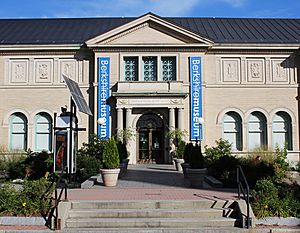Berkshire Museum facts for kids
 |
|
| Established | 1903 |
|---|---|
| Location | Pittsfield, Berkshire County, Massachusetts, United States |
| Type |
|
| Collections | Natural history, art, ancient Egyptian mummy, Babylonian art |
The Berkshire Museum is a cool place in Pittsfield, Massachusetts. It's like three museums in one! You can explore amazing art, learn about natural history (like animals and plants), and discover ancient civilizations. It's a great spot to see things from all over the world.
Discovering the Berkshire Museum's Past
The Berkshire Museum was started in 1903 by a local paper maker named Zenas Crane. He owned Crane & Company, which made paper for the U.S. Treasury. Mr. Crane was inspired by famous museums like the American Museum of Natural History and the Metropolitan Museum of Art. He wanted to create a special museum for the people of Western Massachusetts.
How the Museum Began
Zenas Crane used his wealth to help his community. He personally bought many of the first items for the museum. He wanted to bring a wide variety of amazing things from around the world to the Berkshires. The museum building was designed by a local architect named Henry Seaver.
Some of the first artworks Mr. Crane bought were paintings from the Hudson River School. These included important works by artists like Albert Bierstadt and Frederic Edwin Church.
Early Leaders of the Museum
The museum's first curator was Harlan Hoge Ballard. He worked there until 1931. After him, Laura M. Bragg became the director of the museum.
Amazing Collections to Explore
The Berkshire Museum has over 40,000 objects from almost every continent! It's like a "window on the world." You can find all sorts of interesting things here.
Natural History and Ancient Wonders
The museum has many cool natural history items. These include collections of fossils and a huge 143-pound meteorite! You can also see an ancient Egyptian mummy and pieces of Babylonian clay tablets with old writing. There are even samples of old jewelry from the Mediterranean region.
The museum also shows off the nature of the Berkshires. You can see examples of local mammals, birds, reptiles, fish, insects, plants, and minerals.
Items from American History
The Berkshire Museum also keeps items connected to famous Americans. Zenas Crane helped support Robert E. Peary and Matthew Henson's trip to the North Pole in 1908-1909. The museum now has Matthew Henson's full fur suit and the sledge they used on their journey.
You can also see the writing desk of famous author Nathaniel Hawthorne. There's even a musket believed to have belonged to Israel Bissell. He was a friend of Paul Revere and made a famous midnight ride to warn people that the British were coming!
Famous Artists and Modern Art
The Berkshire Museum has shown works by many famous artists from the U.S. and other countries. These include Gilbert Stuart, Rembrandt Peale, John Singleton Copley, Thomas Sully, Paul Cézanne, Pierre Auguste Renoir, and John Singer Sargent.
In the 1930s, the museum was the first to ask Alexander Calder to create special "mobiles" for them. Mobiles were a new kind of art at the time, and Calder became a very important artist. In the 1950s, the Berkshire Museum was also the first to display the work of Norman Rockwell. They also showed art by artists who liked to try new things, like Andy Warhol, Red Grooms, Robert Rauschenberg, Ellsworth Kelly, and Nancy Graves.
The museum continues to get new items through purchases and gifts. In recent years, they have focused on adding works by artists who are well-known and have strong connections to the Berkshires. These artists include Gregory Crewdson, Peter Garfield, Morgan Bulkeley, Stephen Hannock, and Tom Patti.
Gallery
-
Alexander Calder, Bear and Cart Toy, 1927
Museum Updates and New Exhibits
The Berkshire Museum often updates its exhibits to keep things exciting.
Feigenbaum Hall of Innovation
In March 2008, the Feigenbaum Hall of Innovation opened. This new hall fits with the museum's idea of being a "curiosity cabinet." It celebrates local inventors and their amazing ideas.
Spark!Lab: A Place to Invent
In October 2014, the museum's "Dino Dig" dinosaur exhibit was replaced by Spark!Lab. This is a fun, hands-on space where you can act like an inventor! It was created by the Jerome and Dorothy Lemelson Center at the National Museum of American History.




